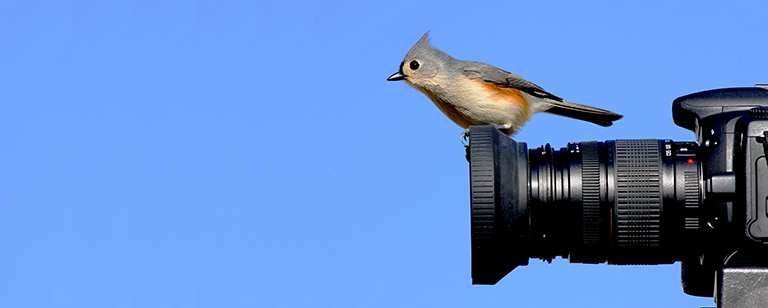For me, this time of year is “for the birds”

Tufted Titmouse (Baeolophus bicolor) looking for birds. — photo by Steve Byland
For those of you that know me, you understand what a bird watching nut I am. I set my alarm extra “extra” early, whip down to the office to check on your PIA (pain in the @#$) Jobs and then head out to enjoy the fresh waterfront air and the return of millions of migrating birds to our north coast area. So far I’ve witnessed dozens and dozens of species return to nest, feed and rest up, before making their flight north to Canada. Without a doubt, my favorites still are the yellow tipped bent beak Yappaloo and the Canadian Green Breasted Canvas Back Longneck Moorehead Loon. So take my advice, before you break out the fertilizer or dig into the gardens, take a day or two with friends and family and enjoy the sights and sounds of hundreds of “one of a kind” species of birds and water fowl. Hope to see you lakeside (if you can find me in my KHT cammo gear).
Where To Go: Thanks to the Ohio Department of Natural Resources, recommended birdwatching is divided into seven specific “loops” stretching from Ashtabula to Toledo. Here are just five of our favorites. (special thanks to the Ohio Department of Natural Resources website for this info – lakeeriebirding.ohiodnr.gov.
Ashtabula Loop: Tucked in the extreme northeastern corner of Ohio, this section of the Lake Erie Birding Trail features the least developed shoreline on the trail. Five sites are featured on this loop, and one of them, Conneaut Harbor, has produced in an inordinate number of very rare birds. The total species list for this loop is 313, and two of those – Red-necked Stint and Black-throated Sparrow – have only been found in this region.
Cleveland Loop: This loop is the most populous region on the trail, (28 sites) as the city of Cleveland and neighboring areas are the most developed locales on Ohio’s Lake Erie shoreline. Every type of habitat found along the lake occurs on this loop, and some of the sites are among the most famous birding hotspots in the Midwest. The total species list for this loop is 356, and a remarkable 12 of those have only been recorded in this region. Be sure to visit Whiskey Island and the Edgewater Cleveland Metroparks area (go to clevelandmetroparks.com for events and guided tours.)
Huron and Lorain Loop: The section of Lake Erie between the Huron and Lorain encompasses the “bottom of the bowl;” the southernmost curve of the lake. The fourteen sites in this region offer some of the finest birding in Ohio. The varied habitats include a power plant’s warm water outlet, sandy beaches, expansive woodlands, marshes, and reservoirs. The total species list for this loop is 325. Slightly inland are Oberlin and Wellington reservoirs; magnets for ducks, plus scoters and long-tailed duck are regularly found. Findley State Park and Vermilion River Reservation are two sites that offer excellent woodland birding, and massive restored wetlands at Sandy Ridge Reservation have become famous for wetlands species such as bitterns, rails, and Sandhill Crane.
Sandusky Bay Loop: The most prominent bridge along Ohio’s Lake Erie shoreline is the State Route 2 span over massive Sandusky Bay. Historically, the bay was ringed with mixed-emergent marshes and prairie wetlands, most of which have been destroyed. However, large marshlands are still protected and provide some of the most important bird habitat along Lake Erie. Sandusky Bay and vicinity is a very important stopover area for migratory waterfowl. The total species list for this loop is 313, and three of them – Black-bellied Whistling-Duck, Magnificent Frigatebird, and Ancient Murrelet – have only been found in this region.
Lake Erie Islands Loop: The East Sandusky Bay Metropark is an assemblage of four contiguous but separately named parks that total about 1,200 acres. Huge numbers of waterfowl use the area in migration, including counts of Tundra Swans that can number into the thousands. Ohio’s Lake Erie islands are part of a limestone archipelago and feature seventeen islands, not all of which are accessible. Three of the readily accessible islands are featured in this loop (Kelly’s Middle Bass and South Bass) offer a very different type of adventure than birding the other loops on this trail and one should set aside at least a full day to explore them. The total species list for this loop is 294, and two of them – Great Gray Owl and Baird’s Sparrow – have only been found in this region.
What To Look For: chickadees, tufted titmouse and cardinals, great horned owls herons, hawks and crows, male red-winged blackbirds, hardy eastern phoebes, fox sparrows, bald eagles, yellow-bellied sapsuckers, red-shouldered, cooper’s and red-tailed hawks rearing their young, great horned and barred owl owlets. From the high bluffs of Huntington Reservation, one can witness fantastic numbers and diversity of diving ducks, grebes and loons as they prepare to push north towards nesting grounds. Riding nighttime southerly winds, the first waves of warblers, sparrows and thrushes arrive on the north coast stopping in Ohio only to refuel before continuing their journey north. Others like orioles, grosbeaks and tanagers return to begin their nesting cycle while common grackles, mourning doves and American woodcocks.
For more information, visit: ohiobirds.org, mageemarsh.org, Cleveland.com/neobirding.
Be sure to give me a call and let me know how your trip went.
Oh, and if you’re reading this on April 1, 2016, April Fool!!



Leave a Reply
Want to join the discussion?Feel free to contribute!